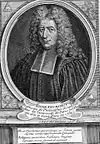Edmond Pourchot
Edmond Pourchot (1651, Poilly – 1734, Paris) was a university professor noted for his controversial advocacy of Cartesianism (and the Cartesian theory of mechanics) in place of Aristotelianism.[1][2] The change within the University of Paris from Aristotelianism to Cartesianism during the 1690s was important in the history of the development of natural philosophy in France and continental Europe.[3][4]

Pourchot was named Professor of Philosophy in 1677, and he was a long-standing vice-chancellor/rector of the University of Paris, where he taught for 26 years. He authored a popular multi-volume Latin text entitled Institutiones philosophicae ad faciliorem veterum, ac recentiorum philosophorum lectionem comparatae (Paris, 1695; Paris, 1700; Lyon, 1711; Venice, 1715; Lyon, 1716–1717; Venice, 1730 [standard edition]; Paris & Lyon & Padua, 1733; Padua, 1751; Venice, 1755).[5][6] This text was well regarded among eminent French intellectuals, and gained followers for Cartesianism in many other countries including Turkey and Poland.[7][8] He was also a scholar of the Hebrew language. The Latin form of his name was Edmundus Purchotius (Edmundi Purchotii).

- Volume 1[9][10] - Logic and metaphysics
- Volume 2[11] - Geometry and general physics (including optics, hydrodynamics, simple machines, thermodynamics, and dynamics featuring projectiles, pendulums, etc.)
- Volume 3[12][13] - Cosmology (heliocentric and geocentric), botany, zoology, human anatomy, meteorology, astronomy, magnetism, metallurgy, and geography
- including a world map showing Terra Australis, the Prime Meridian passing through El Hierro, and the Island of California (Table 24)
- including a presentation of heliocentric Cartesian ethereal vortices in/around the solar system (Table 20)...[14] this theory was supported by many notable scientists (for example Christiaan Huygens and Johann Bernoulli) prior to being supplanted by Newtonian mechanics (published 1686)[15][16]
- including an armillary sphere showing the plane of the ecliptic on the celestial sphere (Table 16)
- including an illustration of magnetic field lines which were not fully understood for another 150 years until Faraday and Maxwell (Table 26)
- Volume 4[17] - Ethics
- Volume 5[18] - Philosophy (including metaphysics and ontology)
Plates (Tables 16, 20, 24, 26) from Institutiones Philosophicae (Pourchot, 1717)




See also
References
- "Archived copy". Archived from the original on 2011-07-16. Retrieved 2010-05-29.CS1 maint: archived copy as title (link)
- Watt, R. Bibliotheca Britannica; Or a General Index to British and Foreign Literature. Edinburgh, 1824.
- Brockliss, Laurence. The Moment of No Return: The University of Paris and the Death of Aristotelianism. Science & Education, March 2006, pp259-278.
- Santinello, G. & G. Piaia. Models of the History of Philosophy. Springer, 2011.
- Dates and places of publication from Heritage of the Printed Book database, COPAC, and BnF catalogues.
- it:Edmond Pourchot
- Chalmer's Biography, 1812, vol 25, p239.
- Shaw, S.J. History of the Ottoman Empire and Modern Turkey. Cambridge University Press, 1976.
- Pourchot, Edme (1711). Institutiones philosophicae ad faciliorem veterum.
- Pourchot, Edmond (1711). Institutiones philosophicae ad faciliorem veterum ac recentiorum ...
- Pourchot, Edmond (1751). Institutiones philosophicae ad faciliorem veterum, ac recentiorum ...
- Pourchot, Edmond (1751). Institutiones philosophicae.
- Pourchot, Edmond (1711). Institutiones Philosophicae.
- Descartes' Physics. Metaphysics Research Lab, Stanford University. 2017.
- Lakatos, Imre. The Methodology of Scientific Research Programmes. Cambridge University Press, 1978.
- Solomon, Joan. The Structure of Space. Wiley, 1974.
- Pourchot, Edme (1715). Institutiones philosophicae, 1.
- Pourchot, Edmond (1760). Institutiones Philosophicae.